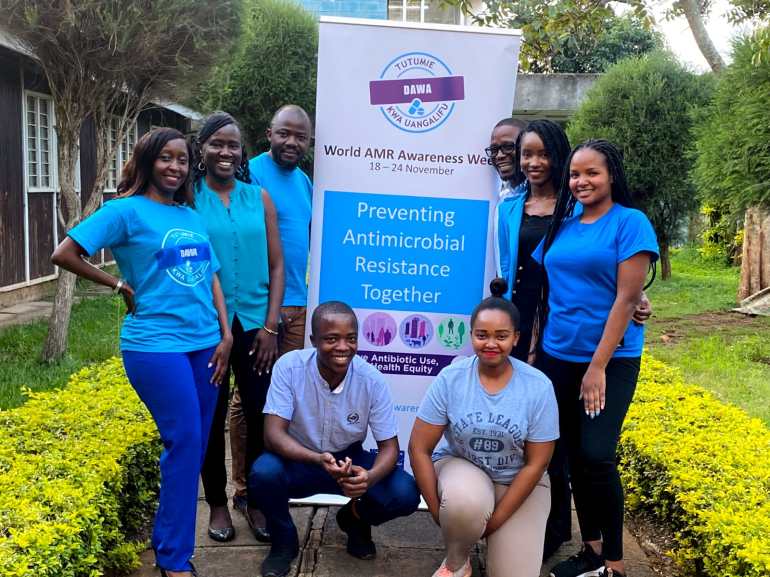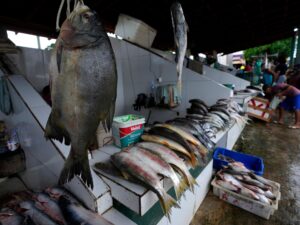Antimicrobial resistance, or AMR, is a rising global health concern – with doctors, scientists and public health experts sounding the alarm that some of the world’s most reliable antibiotics are becoming less effective against so-called “superbugs”.
AMR occurs when bacteria, viruses and parasites no longer respond to medicines, making people sicker and increasing the spread of infections, according to the World Health Organization (WHO).
“Antimicrobial resistance threatens a century of medical progress and could return us to the pre-antibiotic era, where infections that are treatable today could become a death sentence,” WHO Director-General Dr Tedros Adhanom Ghebreyesus warned this month.
AMR is thought to contribute to millions of deaths every year, and will cause increased suffering, particularly for low- and middle-income countries, the WHO said. The world needs new solutions, according to health experts.
Dr Sylvia Omulo – a doctor of epidemiology, who holds a PhD in immunology and infectious diseases from the College of Veterinary Medicine at Washington State University – studies AMR. She works at their campus in Nairobi, Kenya.
For almost 20 years, she has investigated the links between humans, animals and their shared environments, and the microbes that live inside all of them.
Omulo doesn’t study the microbes that kill us. She studies those that don’t, but that might give us clues to better understand the complex ecosystems that coexist with us inside our guts, noses and on our skin.
She calls these microbes “colonisers”, because of the way they spread, often harmlessly, inside humans and animals.
By looking at them, she’s identified genes that correlate to AMR; why some people and some animals are more susceptible to resistant microbes; and how those traits are distributed within a community and in hospitals. She’s identified environmental and behavioural factors that might be essential to understanding AMR.
Omulo’s work begins not in the hospital but in the community – in the mud-built, tin-roof homes of Nairobi’s largest shanty town, Kibera, and on farms at the shores of Lake Victoria.
Al Jazeera spoke to Omulo – who is among a select few scientists to advise the WHO on new directions in AMR research – about the study of antimicrobial resistance and advances in the battle to tackle it.

Al Jazeera: Are there biases in the way that the scientific culture currently approaches the study of AMR?
Dr Sylvia Omulo: My quickest answer would be, yes.
Yes, in the sense that [the study of] AMR is very tied to the use of antibiotics. When I entered this field, I looked at papers about AMR in the Eastern African region, and a lot of articles claimed that AMR is only an antibiotic-use problem.
As it turned out, most of these papers were based only on clinical samples; they studied patients in hospitals.
But there’s a problem: In those studies, you’re only looking at the most sick patients. When [you] test patients in a hospital setting, and you find antibiotic-resistant bacteria, you assume it’s because it was acquired in hospital.
The population [of sick patients in hospital] becomes biased in the sense that they are just more likely to have an antibiotic-resistant bacterial strain than a population that has not used antibiotics [but that’s a correlation, not necessarily the cause].
If this is the only data we study, there’s bias in what we classify as the driver of AMR: We assume it’s improper antibiotic use.
Very few studies look at AMR in a community context, and that’s what the bulk of my research work is.
I think it’s very hard to do community-based research studies in the Global North, in places like the US, because recruiting patients from the community is [actually] very hard. Within a hospital setting, you will most likely find that it’s not even outpatients – those who visit and then go back home – it’s inpatients [that researchers have access to].
When you come to the [Global] South, the approach is different. We sample mainly from populations or people who are just visiting healthcare facilities; the kind of science here is very public health-focused.

Al Jazeera: What are ‘coloniser’ bugs and how are these different from infections?
Dr Omulo: AMR has been portrayed over the past 10 years, particularly in the media, using the word “superbug”. We imagine lethal bacterial infections that spread quickly, with no countermeasures.
[We’re] not looking at those bacteria. No, we look at what are called “colonisers”.
There’s a difference between colonisation and infection. These are the bugs that people carry without necessarily showing symptoms. Some of these colonising bugs are very similar to what we find in hospital strains.
We try to understand why people carry antibiotic-resistant bacteria in their gut and in their nose. We look at E coli, and others from that group of bacteria, and MRSA, methicillin-resistant staphylococcus. [MRSA infections are common in hospital settings. They can spread quickly and cause complications. Untreated MRSA can be deadly.]
[When we study] E coli, we look at what combinations of antibiotics the bug is resistant to, then, what are the genes or the factors that contribute to resistance.
Al Jazeera: How important is the environment where research is conducted?
Dr Omulo: I wanted to find out: If you’re not in a hospital setting, but you carry these AMR bugs, what’s contributing? Why do [these microbes] enter certain people, and not others?
I found three articles of studies that had been done in other countries: Bolivia, Ecuador, and Peru. They had looked at what happens within a community. They did not find significant relationships between AMR and antibiotic use.
And so I transferred the question to the Kenyan context and asked what could be contributing to the problem here. And one of the issues I found was sanitation.
Where there’s poor sanitation, people ingest [microbes], carry them, and shed them and transmit them within the same environment.

Al Jazeera: What is it like in Kibera, and why is the shanty town uniquely interesting to you as a researcher?
Dr Omulo: Kibera was a great area to test the hypothesis that sanitation is as important, perhaps even more important, in the transmission cycle of AMR as antibiotic use.
In the 2019 census, the density of Kibera was 66,000 people per square kilometre. If you think of New York City, which has a population density of 11,000 per kilometre square, [Kibera] is almost [six] times more dense. So people are almost living on top of each other. There’s really no way to separate yourself from your sick neighbour because you live in very close proximity to each other.
In Kibera, many of the households are about three metres by three metres, and that can house a family of up to 11. I think at most I saw 15 people living within the same household in a single shared room. But on average, it’s anywhere between five to seven people.
And these are mainly tin houses, mud-built. A few have tile floors, but it’s a mishmash of different building materials. So it’s not your regular structured house, and that’s what characterises informal settlements.
Sanitation is really poor because in many slum areas all over the world, it’s very hard to have clean, steady water systems and sewer systems. This kind of environment really drives transmission, really drives the spread of not just resistant bacteria, but diseases in general.
[In Kibera] antibiotics are cheap and plentiful, and some vendors just walk around selling them.
And essentially, what we found is that when we collected samples from people, tested their water, tested their environment, we found a lot of these resistant bugs in the environment. And when we tested the soil samples from within the area, it had lots of resistant bugs.
Generally, we want to know, what happens in this human population that could contribute to AMR.
Al Jazeera: What are some of the things you’ve found there?
Dr Omulo: In 2016, when we did our analysis of about 200 households that we followed up for every two weeks for five months, we found no relationship between AMR and antibiotic use. We did find a direct relationship with environmental transmission factors. So it appeared that even if antibiotic use played a role in AMR, the poor sanitary conditions in the environment may have even masked the role of AMR. Context is important.
It appears that there’s some genetic factors or predisposition within an individual that either protects them or makes them [more] susceptible to infection with these bugs. So if you’re colonised with an [antimicrobe]-resistant bug, you’re more likely to be infected by [another antimicrobe]-resistant bug.

Al Jazeera: What are the most interesting discoveries you’ve made?
Dr Omulo: There are two different settings that I’ve studied – the slums of Kibera, and more rural settings. [Omulo also collects samples from people who live in rural farms in Asembo, near Lake Victoria.]
We ask questions broadly in the two settings because we were conducting the same study. We asked what animals people keep, to try to understand if this contributes to AMR.
So, if you reported having poultry within your household – chicken – and most rural households reported keeping some sort of poultry in the house, there were also higher rates of AMR.
That itself was not in itself a surprise finding because the relationship between AMR transmission and poultry keeping has been documented by several other studies.
But another relationship we found was, for households that said they visited a healthcare facility, whether it’s for medical or non-medical reasons, they were more predisposed to carrying AMR bugs than households that did not report visiting a medical facility.
So it appears that there is a role that healthcare facilities play. But we are not sure what. Is it that when you carry these bugs, you’re more likely to go to a healthcare facility? Or is it contact with a healthcare facility that is more likely to contribute to carrying the bug? So right now we are following these people, particularly mothers and their children, for a year. And every two weeks, we collect samples, but we also ask them questions about water sanitation, hygiene, antibiotics use, animal exposures, among others and all those, to try to understand what precedes the other.
We are trying to ask whether colonisation [by non-lethal microbes] impacts your health in any way. Does it contribute to more diarrhoeal episodes than for someone who’s not colonised? Does it contribute to more respiratory infections? For children, we are tracking their growth milestones to figure out whether children who are colonised are less likely to meet or to keep up with growth milestones compared to those who are not colonised.
We’re also trying to understand the colonisation process. Do people stay colonised throughout or are they colonised at specific times?
So this phase of the study is really detailed, has a lot more interaction with the same people to try to understand how colonisation impacts their day-to-day activities or impacts their health.
In general, in community settings, the factors that drive AMR are very different from what drives AMR in a hospital setting.
Al Jazeera: We’ve heard a lot about how AMR is an urgent global threat; the United Nations is discussing this topic at the General Assembly. Do you feel part of the global push to understand AMR?
Dr Omulo: I was one of four Kenyans that were invited by the WHO to try to figure out what the research focus areas for AMR should be in the global context.
I think the big role that the kind of work we do adds to the global understanding of AMR is that we can’t ignore what’s happening in the community. Before and after people leave hospitals, they come from a community, and afterwards they return. So all the processes that happen there contribute to what you see in the hospital.
Does that mean if you stop using antibiotics, [AMR] will go away? Absolutely not. There are lots of studies that show that AMR hangs out in the environment, years after antibiotic use has been stopped.
So until we understand this problem, we are only just touching one part of the elephant without realising that the elephant is a much bigger animal with different textured parts.
This interview has been edited for clarity and brevity.









More Stories
Publicist says Maggie Smith, acting great known to millions from Harry Potter and ‘Downton Abbey,’ has died at age 89
‘Saturday Night Live’ begins 50th season this weekend
If we want to build a better future, we all need to eat more fish